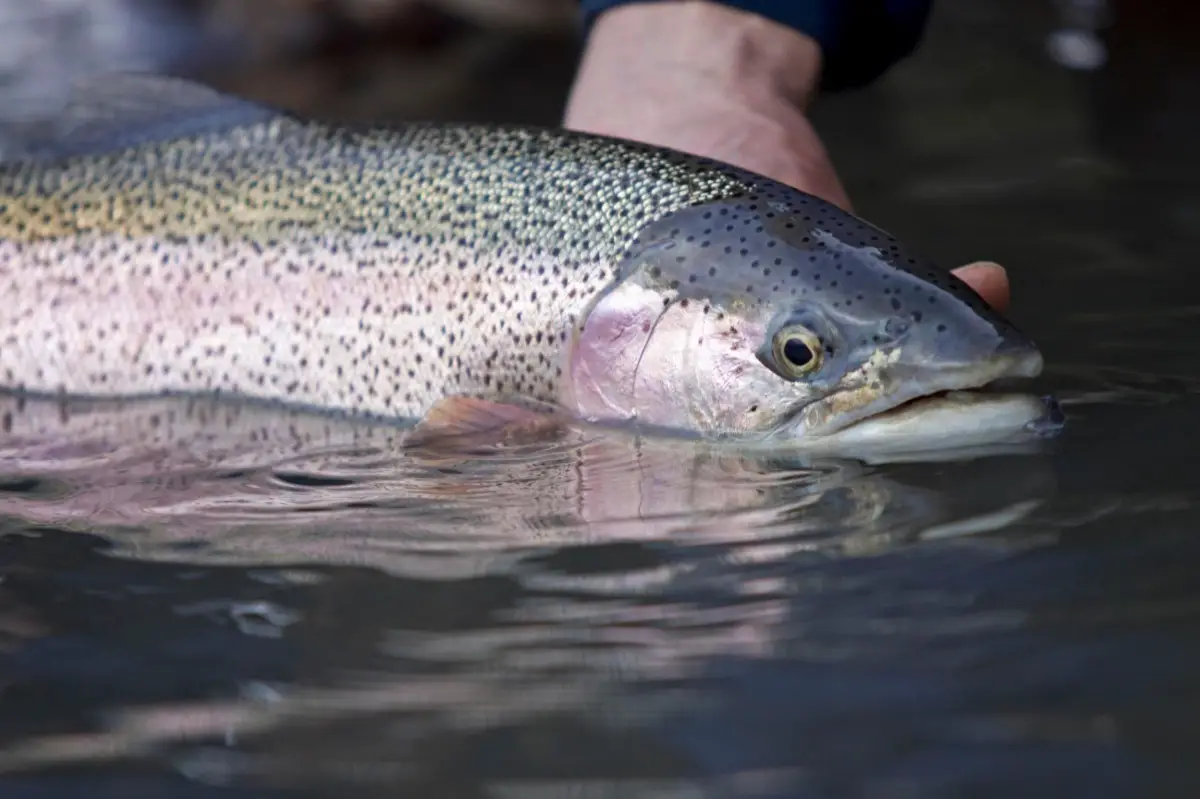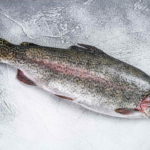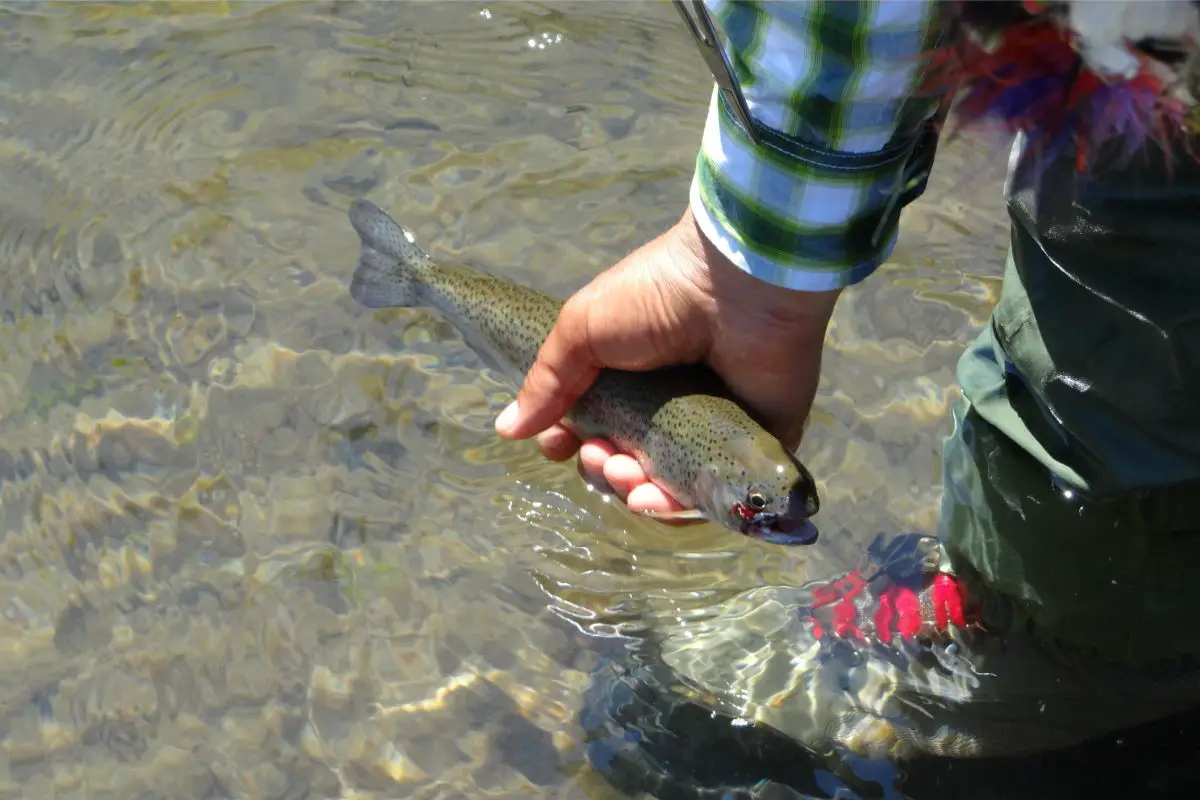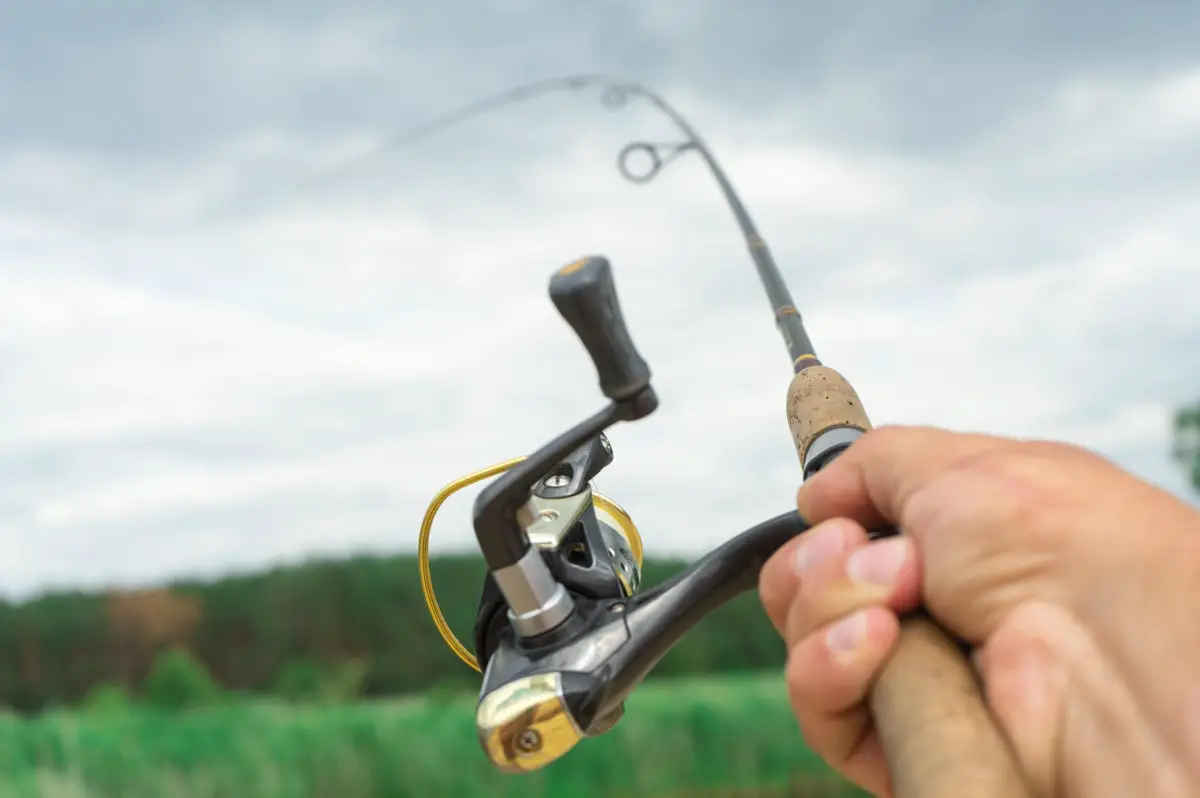The rainbow trout (Oncorhynchus mykiss) is a salmonid endemic to northern Asia and North America’s tributaries of the Pacific Ocean. The ocean-going trout, known as “steelhead,” is an anadromous form of the coastal rainbow trout or Columbia River rainbow trout that spends two to three years in the ocean before returning to freshwater to reproduce. The important question to answer is what do rainbow trout look like?
Rainbow trout are beautiful fish with a shiny silver pattern throughout their main body and a pink(or purple) stripe running along the lateral line. They’re torpedo-shaped and usually olive-green with black patches covering their upper body, fins, and tail. Their underside is entirely white from their chin to their anal fin.
Of course, colors and patterns can vary depending on the environment, age, and spawning conditions. The pink stripe gives them a unique, almost rainbow pattern along their body, hence their name.
Keep reading to find out more about what rainbow trout look like, when they evolved into being, and so much more!
What Does a Rainbow Trout Look Like?
Rainbow trout are a popular recreational fish in North America, and their name comes from the beautiful colors that shimmer on their skin. The rainbow trout’s coloration changes dramatically from courtship through intercourse, environment, and maturity changes.
The color of the fish’s back can range from brown to olive to dark blue. A pinkish stripe or band runs the length of the fish’s body, with a silvery underside that fades to pearl white. Their backs, fins, and tails bear tiny black dots.
The average adult fish is 16 inches (40.64 cm) long and weighs about two pounds(0.90 kg). They are members of the salmon family tree and, like their salmon cousins, may grow to be extremely large.
However, a few rainbow trout catches range up to 30 inches (76.2 cm) long and weigh up to 12 pounds (5.44 kg) on average. Although some will leave their freshwater habitats and follow a river out to sea, they prefer cold, clear rivers, streams, and lakes.
These migratory adults, called steelheads because of their silvery patterns, will spend several years in the ocean but return to the stream they were born to reproduce. Rainbow trout are carnivores and eat primarily bugs and tiny fish when in freshwater.
Their populations are generally healthy, and they have no special status or safeguards. However, Native ocean-going rainbow trout (Steelhead) are endangered in many areas and have strict rules for harvest.
Diagram of a Rainbow Trout
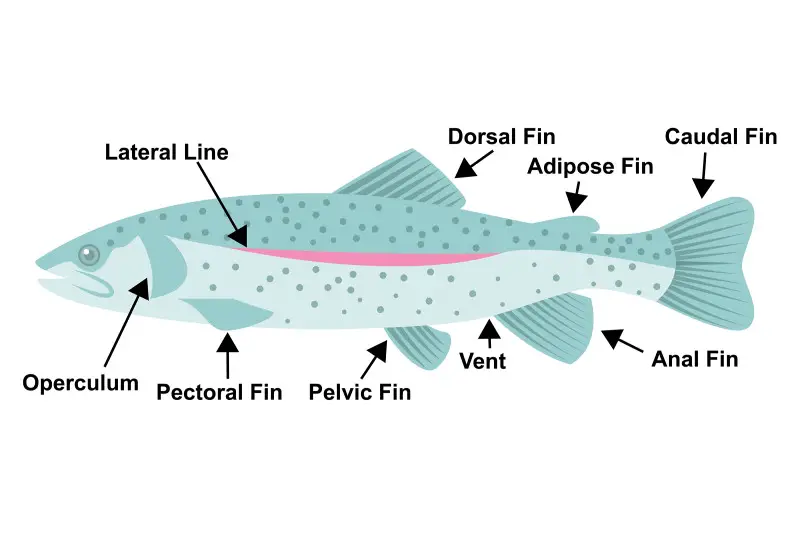
What Do All These Rainbow Trout Features Mean?
You can use all of these different rainbow trout features to differentiate rainbow trout from other species of fish. Salmonids can look a lot alike, but the rainbow trout’s distinctive features set it apart from others.
A fusiform body, forked tail, adipose fin (a fleshy fin without inner aids along the midline of the lower back between dorsal fin and tail), and a more extensive fleshy or scaly line (axillary scale or way) at the bottom of each pelvic fin are commonly used to differentiate salmonids.
Closely related smelts (Osmeridae) have an adipose fin. Still, they lack the axillary procedure, whereas North American catfishes (Ictaluridae) have an adipose fin but lack scales and have conspicuous barbels on the chin. The rainbow trout’s frame is usually elongated, but it becomes immensely deeper and compressed in larger fish.
The top jaw frequently extends to or past the back edge of the bottom jaw and is slightly behind the eye’s position. The upper and lower jaws both have small needle-like teeth. Other teeth are located on the Vomer, Platatine, and something similar to teeth on the tongue.
Adult rainbow trout have a silvery coloration with black spots on the back and at the dorsal, adipose, and caudal (tail) fins, as well as a pink-to-pink band along the lateral line. The pink color is also found on the gill plate and becomes more prominent as the fish ages.
The back is usually dark green but can be blue to brown, silvery-white to light yellow lower sides, and belly. Habitat, length, and sexual condition all influence coloration. Stream dwellers and spawners are darker and have more dramatic colors, whereas lake dwellers are lighter, brighter, and extra silvery.
Five to 13 black ovals or “parr markings” are present on the sides of juveniles but fade, and the trout matures.
The fins (except the adipose) are supported by segmented, branching tender rays (no actual spines); fin ray counts are as follows:
- Dorsal: 10-12
- Caudal (tail): 19
- Anal: 8-12
- Pelvic: 9-10
- Pectoral: 11 -17
With 110 to 160 pored scales along the lateral line, 18 to 35 scale rows above the lateral line, and 14 to 29 rows below, scales are tiny and easily removed.
There are nine to thirteen branchiostegal rays in all. Peripheral pigments vary depending on strain and environment; commercially available strains include yellow (golden) and blue. Fillets come in two colors: white and pink.
How Many Species of Rainbow Trout Exist?
There are over two dozen various species and subspecies of rainbow trout swimming in the world’s waters today. Some are freshwater, and others are saltwater.
However, we will discuss the most common and mostly farmed and consumed species of rainbow trout.
The Coastal regions offer two species of rainbow trout; the Beardslee trout (O.m. irideus var beardsleei) and the Coastal rainbow trout. The coastal rainbow trout are found in the tributaries of the Pacific Ocean from Alaska’s Aleutian Islands south to Southern California.
Steelhead is the name for anadromous species, whereas rainbow trout is the name for freshwater forms. The beardslee trout is a genetically distinct lake-dwelling variant of the coastal rainbow trout isolated in Lake Crescent, Washington.
The Red Band subspecies of rainbow trout include:
- The Sheephaven Creek redband trout. Sheepheaven Creek, Siskiyou County, and California are home to these subspecies. In 1972 and 1974, red band sheep from Sheepheaven Creek were transferred into Swamp Creek, and in 1977, they were transplanted into Trout Creek.
- The Columbia River redband trout swims in Montana, Washington, Idaho, and the Columbia River and its tributaries. Redband steelhead is anadromous steelhead.
- The Eagle Lake trout swims in Eagle Lake in Lassen County, California, where this species may be found.
- The McCloud River redband trout is indigenous to the McCloud River and its tributaries in Northern California, south of Mount Shasta, and upstream of Middle Falls.
Lastly, there is the Kern River golden trout. The Kern River and its tributaries are endemic to the species. Its current range is significantly less than its previous range. The Kern River above Durwood Creek, upper Ninemile, Rattlesnake, Osa streams, and potentially upper Peppermint Creek have remnant populations.
A common subspecies of the Kern River golden trout is the Little Kern golden trout which is only found in Tulare County, California, around 100 miles (160 kilometers) of the Little Kern River and its tributaries. Their present distribution is limited to eight Kern River headwater streams:
- Wet Meadows
- Deadman Creek
- Upper Soda Spring
- Clicks Creek
- Burnt Corral Creek
- Tamarack Creek
- Cayote Creek
- Fish creeks
What Is the Most Common Species of Rainbow Trout?
The most common species of rainbow trout is the Kamchatkan rainbow trout (O.m. mykiss). It is a subspecies of the rainbow trout (Oncorhynchus mykiss), which belongs to the Salmonidae fish family.
It comes from the Russian Far East. Its primary range is on the Kamchatka Peninsula, although it has also been seen in the Commander Islands east of Kamchatka and infrequently in the Sea of Okhotsk, as far south as the Amur River’s mouth.
The Kamchatkan rainbow trout is mainly found in the Western Pacific parts of the Kamchatka Peninsula and the Commander Islands east of Kamchatka and infrequent sightings in the Sea of Okhotsk as far south as the Amur River’s mouth.
How Long Ago Did Rainbow Trout Evolve?
Brown trout, Salmo trutta, and Oncorhynchus mykiss evolved and split into two groups roughly 15-20 million years ago, but they belong to the same family (the Salmonidae). They are, however, separate species in different genera.
In the North Pacific, Oncorhynchus became isolated, whereas Salmo was isolated in the North Atlantic.
Conclusion
Rainbow trout are one of the most beautiful fish in the world. The sleek shape and bright shiny colors invoke a classic image of a fresh fish.
Species of rainbow trout have been introduced into streams and lakes throughout North America due to their appeal as a game fish. Stocking(hatchery) programs make this beautiful fish available for the average person to enjoy any time they desire.
